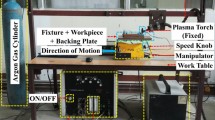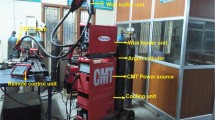Abstract
The widespread application of nickel-based alloys as structural materials in chemical, nuclear and power generation industries is often limited due to weldability issues. Technological and metallurgical problems such as lack of fusion or hot cracking require specific welding guidelines as well as knowledge of the welding metallurgy to produce welds that fulfill high quality requirements. Due to the lower heat input modified dip arc welding is a potential alternative joining technique for hot crack sensitive nickel-based alloys. This paper contributes to the application of modified dip arc processes for butt welding of alloy 617 (2.4663). The influence of reduced heat input on microstructural and mechanical properties were investigated. Particular attention was given to the occurrence of hot cracking in the weld metal and base metal HAZ (heat-affected zone) using light optical microscopy, EDS analysis and electron probe microanalysis. The results indicate that the modified dip arc processes provide excellent weld quality and economic efficiency. However, microstructural observations showed that hot cracking in the form of microcracks could not be completely avoided. The modified dip arc welded joints exhibited good tensile strength and impact toughness. The mechanical properties are comparable to commonly GMA (gas metal arc) pulsed arc welding and are not influenced by the microcracks.














Similar content being viewed by others
References
Egerland S, Helmholdt R. Overlaying (cladding) of high temperature affected components by using the cold metal transfer process. Proceedings of the IIW 2008 International Conference on Safety and Reliability of Welded Components in Energy and Processing Industry, Graz, Austria, 2008, pp. 327–332
Borden, M. P.: Weldability of materials for ultrasupercritical boiler applications, Proceedings from the Fourth International Conference on Advances in Materials Technology for Fossil Power Plants, 2004, pp. 837–853.
Bader M, Klöwer J, Husemann R-U (2010) Metallkundliche Aspekte bei der Herstellung von Komponenten aus Alloy 617 für 700 °C Kraftwerke, Metallurgical aspects of the manufacturing of components of alloy 617 for 700 °C power plants. VDI-Berichte 2102:13–26 (in German)
Maile K, Klenk A, Speicher M (2008) Rissempfindlichkeit von Alloy 617 für Rohrleitungen, Crack sensitivity of alloy 617 for pipelines, 31. Vortragsveranstaltung der Arbeitsgemeinschaft für warmfeste Stähle und der Arbeitsgemeinschaft für Hochtemperaturwerkstoffe, Düsseldorf, pp 139–150 (in German)
Shah Hosseini H, Shamanian, Kermanpur A (2011) Characterization of microstructure and mechanical properties of Inconel 617/310 stainless steel dissimilar welds. Mater Charact 62:425–431
Fink C, Keil D, Zinke M Evaluation of hot cracking susceptibility of nickel-based alloys by the PVR test, Welding in the World 56 (7–8), pp. 37–43
Kihara S, Newkirk JB, Ohtomo A, Saiga Y (1980) Morphological changes of carbides during creep and their effects on the creep properties of Inconel 617 at 1000 °C. Metall Mater Trans A 11A:1090–1031
Mankins WL, Hosier JC, Bassford TH (1974) Microstructure and phase stability of Inconel alloy 617. Metall Trans 5:2579–2590
Bassford TH, Hosier C (1984) Production and welding technology of some high-temperature nickel alloys in relation to their properties. Nucl Technol 66:35–43
DuPont JN, Lippold JC, Kiser SD: Welding metallurgy and weldability of nickel-base alloys. Hoboken, NJ, 2009
Mandziej ST (1997) Physical simulation of welding, ASM Conference on Welding and Joining Science and Technology, pp. 253–268
Naffakh H, Shamanian M, Ashrafizadeh F (2008) Weldability in dissimilar welds between Type 310 austenitic stainless steel and Alloy 657. J Mater Sci 43(15):5300–5304
Lundin CD, Qiao CYP, Swindeman RW (1993) HAZ hot cracking behavior of HD 556 and Inconel 617. David, S. A.; Vitek, J. M. (eds.): International trends in welding science and technology, Material Park, OH, pp. 801–806
Acknowledgements
These tests were funded by the Federal Ministry of Economics and Technology (BMWi) assisted by the Arbeitsgemeinschaft industrieller Forschungsvereinigungen (AiF — industrial research consortium) “Otto von Guericke” e.V. (IGF-No. 16.316 B/DVS-No. 01.069) and supported by the DVS Forschungsvereinigung Schweißen und verwandte Verfahren e.V. (DVS — German Research Association on Welding and Allied Processes). The authors gratefully acknowledge the support.
Author information
Authors and Affiliations
Corresponding author
Additional information
Doc. IIW-2351, recommended for publication by Commission II “Arc Welding and Filler Metals”.
Rights and permissions
About this article
Cite this article
Fink, C., Zinke, M. Welding of nickel-based alloy 617 using modified dip arc processes. Weld World 57, 323–333 (2013). https://doi.org/10.1007/s40194-013-0034-6
Received:
Accepted:
Published:
Issue Date:
DOI: https://doi.org/10.1007/s40194-013-0034-6




